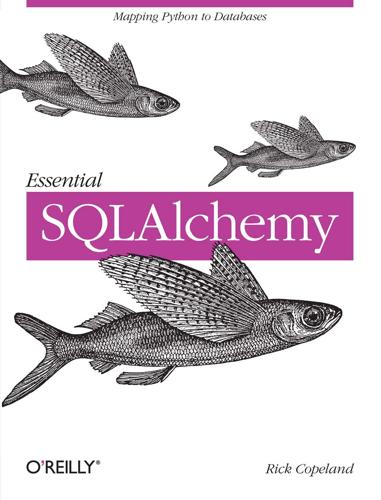
Essential SQLAlchemy
by
Rick Copeland
Published 4 Jun 2008
For instance, if you wish to implement a type for validating that a particular Integer column contains only the values 0, 1, 2, and 3 (e.g., to implement an enumerated type in a database that does not support enumerated types), you would implement the following TypeDecorator: from sqlalchemy import types class MyCustomEnum(types.TypeDecorator): impl=types.Integer def __init__(self, enum_values, *l, **kw): types.TypeDecorator.__init__(self, *l, **kw) self._enum_values = enum_values def convert_bind_param(self, value, engine): result = self.impl.convert_bind_param(value, engine) if result not in self._enum_values: raise TypeError, ( "Value %s must be one of %s" % (result, self._enum_values)) return result def convert_result_value(self, value, engine): 'Do nothing here' return self.impl.convert_result_value(value, engine) It is not necessary to specify in a TypeDecorator the SQL type used to implement the column, as this will be obtained from the impl attribute.
…
Suppose, for instance, that we wished to have a column that stored images from the Python Imaging Library (PIL). In this case, we might use the following TypeEngine definition: class ImageType(sqlalchemy.types.Binary): def convert_bind_param(self, value, engine): sfp = StringIO() value.save(sfp, 'JPEG') return sfp.getvalue() def convert_result_value(self, value, engine): sfp = StringIO(value) image = PIL.Image.open(sfp) return image Once we have defined ImageType, we can use that type in our table definitions, and the corresponding PIL image will be automatically created when we select from the database or serialized when we insert or update the database.
…
If your implementation is more involved, you can directly subclass TypeEngine. Implementing a TypeDecorator To implement a TypeDecorator, you must provide the base TypeEngine you are “implementing” as well as two functions, convert_bind_param() and convert_result_value(). convert_bind_param( self, value, engine) is used to convert Python values to SQL values suitable for the DB-API driver, and convert_result_value( self, value, engine) is used to convert SQL values from the DB-API driver back into Python values. The implemented TypeEngine is specified in the impl attribute on the TypeDecorator. For instance, if you wish to implement a type for validating that a particular Integer column contains only the values 0, 1, 2, and 3 (e.g., to implement an enumerated type in a database that does not support enumerated types), you would implement the following TypeDecorator: from sqlalchemy import types class MyCustomEnum(types.TypeDecorator): impl=types.Integer def __init__(self, enum_values, *l, **kw): types.TypeDecorator.
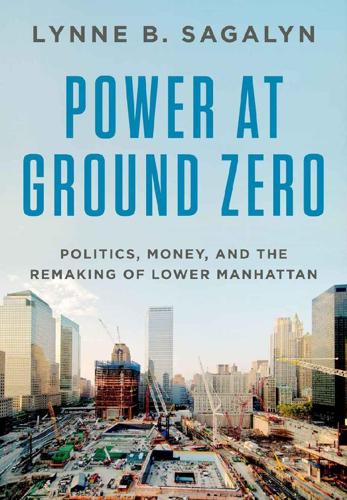
Power at Ground Zero: Politics, Money, and the Remaking of Lower Manhattan
by
Lynne B. Sagalyn
Published 8 Sep 2016
It is an important tool, but the ability to create value, he emphasized, starts with strong management and clear leadership; it starts with the right program (right sized for what the structure will be used for) and the right design (designed efficiently), after which value engineering comes into the picture. It is the “icing on the cake” in a complex project such as the Transportation Hub. The message of the short lesson on value engineering in my off-the-record interview was clear: “Muddled silos of control” do not easily translate to control. The PA was evidently starting to value-engineer its train station at a late stage in the process. It had allowed itself to get locked into a “runaway train” going a hundred miles an hour with no conductor.
…
The cost numbers of that committee looked reasonable, but he had to understand the reasons why costs had escalated so; he did not believe the cost could be $972 million. They set up a war room to review the data, with value engineering as a given. They established an evaluation matrix across three categories (design-layout, materials and value substitutions, and value engineering and construction methodology) and seven criteria (consistency with the Reflecting Absence vision; consistency with the master plan; security implications; dollar impact of construction cost savings; operational costs; schedule impact on September 11, 2009, opening; and practicality).
…
He questioned Phoenix’s estimates because they “rely on outdated 2005 data using preliminary design drawings, rather than updated designs that factor in ongoing value engineering and bid schedules,” and notified the joint venture that those cost figures were “simply unacceptable.”27 It was now unambiguously clear that the FTA’s $280 million project reserve would be needed. Reining in costs to keep within the $2.5 billion budget was going to be exceedingly difficult, and involve an ongoing battle of trading off design elements, value-engineering practicality, constructability, and political considerations. Shorris pledged to preserve the “overall integrity” of Calatrava’s iconic design, but time and further rapidly escalating costs would threaten even that.

The Cohousing Handbook: Building a Place for Community
by
Chris Scotthanson
and
Kelly Scotthanson
Published 1 Nov 2004
❖ Selection process ❖ Contracts ❖ Using professionals effectively ❖ Performance review ❖ Chapter Five: Buying Land .................................................................................... 65 Land is available ❖ Defining expectations ❖ Mapping reality ❖ The search process ❖ to land owners ❖ Making an offer ❖ Trying again ❖ Feasibility analysis ❖ ❖ Project feasibility checklist ❖ Special considerations ❖ Forming an organization ❖ ❖ Summary ❖ ❖ ❖Talking Chapter Six: The Design Process......................................................................... 93 The language of design ❖ Working with your design team ❖ Parallel design tracks ❖ Programming ❖ Goals for the site plan ❖ What if we need to change the program? ❖ ❖ Schematic design ❖ Construction documents ❖ ❖ Value engineering or cost reconciliation ❖ Construction supervision ❖ ❖ Post-occupancy evaluation ❖ Summary ❖ ❖ ❖ Chapter Seven: Design Considerations ............................................................ 125 ❖ ❖ Purposeful separation from the car ❖ Pedestrian pathways ❖ Kitchens facing the pedestrian pathways ❖ Centrally located common house ❖ Optimum community size ❖ Learning from the past ❖ Affordability ❖ How design affects affordability ❖ Design alternatives and housing types ❖ ❖ Site considerations ❖ The common house ❖ Private unit design ❖ Summary ❖ ❖ ❖ Chapter Eight: Environment ............................................................................... 149 ❖ ❖ Use of the car ❖ Site selection ❖ Site planning ❖ Housing types ❖ Reduce, reuse, recycle ❖ Managing costs ❖ summary ❖ Chapter Nine: Legal Issues.................................................................................. 167 ❖ Legal advice ❖ Ownership structure ❖ Setting up your corporation ❖ Summary ❖ Chapter Ten: Finance and Budget...................................................................... 179 It takes money ❖ Language of development financing ❖ Budgets and pro formas ❖ Borrowing money ❖ Other issues ❖ Establishing preliminary unit pricing ❖ ❖ Summary ❖ ❖ ❖ Chapter Eleven: Marketing and Membership ................................................. 203 Why marketing and membership ❖ Who are cohousing people?
…
Check it out before you make an offer. Knowledge is your most valuable tool. 6 chapter The Design Process ❖ The language of design ❖ Working with your design team ❖ ❖ Parallel design tracks ❖ Programming ❖ Goals for the site plan ❖ ❖ What if we need to change the program? ❖ Schematic design ❖ ❖ Construction documents ❖ Value engineering or cost reconciliation ❖ ❖ Construction supervision ❖ Post-occupancy evaluation ❖ Summary ❖ ”Design is desert. It needs be be undertaken only after the legal and financial strategies are identified and the land is under agreement.” The language of design T he language of design varies somewhat.
…
Your design team will want to make presentations to the group, hoping The 7 workshop design process Site P SD Environmental Programming DD CD P SD DD CD VE P Common House = 3 day Weekend Workshop P Private Units SD P SD SD DD DD = = = = = DD Programming Schematic Design Design Development Construction Documents Value Engineering CD CD VE THE DESIGN PROCESS 95 to have the group accept their work. At each meeting you should ask the design team to summarize the outcome of the previous design meeting and then have them present their revised work which responds to specific decisions made by the group at the previous meeting.
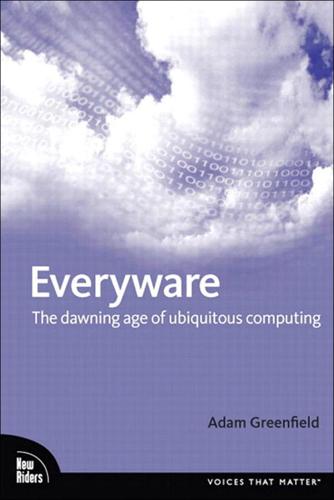
Everyware: The Dawning Age of Ubiquitous Computing
by
Adam Greenfield
Published 14 Sep 2006
Moreover, the more complex the product or service at hand, the more likely it will be to have a misguided process of "value engineering" applied at some point between inception and delivery. Although the practice has its roots in an entirely legitimate desire to prune away redundancy and overdesign, it is disastrous when applied to IT development. However vital, the painstakingly detailed work of ensuring a good user experience is frequently hard to justify on a short-term ROI basis, and this is why it is often one of the first things to get value-engineered out of an extended development process. Even if it's clearly a false efficiency from a more strategic perspective, reducing or even eliminating the user-experience phase of development can seem like getting rid of an unnecessary complication.
…
But we've seen that getting everyware right will be orders of magnitude more complicated than achieving acceptable quality in a Web site, let alone a desktop application. We have an idea how very difficult it will be to consistently produce ubiquitous experiences that support us, encalm us, strengthen and encourage us. Where everyware is concerned, even GOOD won't be GOOD enough. This is not the place for value engineers, not unless they have first earned a sensitive understanding of how difficult the problem domain is and what kinds of complexity it genuinely requires—both in process and product. Thesis 50 Everyware will appear differently in different places: that is, there is and will be no one continuum of adoption.
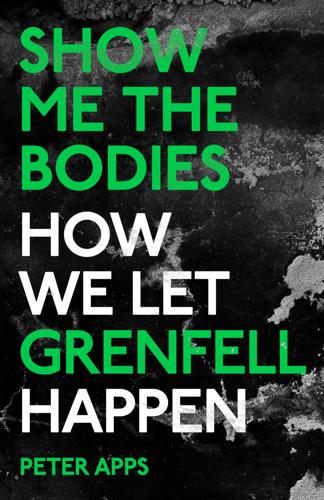
Show Me the Bodies: How We Let Grenfell Happen
by
Peter Apps
Published 10 Nov 2022
The government’s failure to tighten the Class 0 rating meant the cheaper panels could stay on the market. The pure polyethylene was around £2 to £3 cheaper per square metre, which gave it an edge when construction firms tried to squeeze every penny out of their costs through a process known as ‘value engineering’. All Arconic needed to do was persuade builders that their polyethylene-cored product complied with the requirements of Approved Document B. To do this, they sought external certification from the UK construction industry’s most trusted source. The British Board of Agrément (BBA) was initially established by the government in the 1960s to certify construction products as suitable for use.
…
He suggested trying to remove Leadbitter from the job and find another contractor willing to do it more cheaply. ‘Value for money is now the primary driver for the project,’ notes from a project meeting in spring 2013 show.14Artelia was asked to produce a new report giving new advice which supported this course of action. The objective was now getting costs down to RBKC’s budget. The phrase ‘value engineering’ means reducing the cost of a construction project without reducing its quality by finding new materials or cheaper techniques. In reality, costs are cut by substitution with inferior alternatives. With costs perennially pushed down and profit margins always tight, this happens across the construction industry every day.
…
Peter Maddison, who had several contacts at Rydon from previous jobs in housing, got in touch informally to see if the firm could strip a little bit of extra cost out of its bid – something which went against the strict rules of transparency which are supposed to govern the procurement process. On 10 March, Rydon director Steve Blake wrote in an email: ‘Spoke to Peter [Maddison] about the award and they are keen to get going. They need to do a fair amount of value engineering which should be achievable.’16 On 18 March, representatives from Rydon and the TMO sat down to discuss in detail the cost savings they could make. The meeting was secret (described as ‘offline’ in internal emails) and no official notes were taken. The two firms left content that the £700,000 savings they wanted could be made.

Frugal Innovation: How to Do Better With Less
by
Jaideep Prabhu Navi Radjou
Published 15 Feb 2015
These unique attributes of the GVIC’s operating model boost the success rate and impact of its frugal innovation projects. The GVIC is blazing a trail for companies in business model innovation (BMI). Although BMI is the starting point for frugal innovation, most large companies begin on the wrong foot. They first try to reduce the fat from their existing bloated businesses using techniques such as value engineering, business process re-engineering and lean manufacturing. This subtractive approach has two limitations: first, there is only so much waste that can be removed; and second, the leaner business model may still not address the real needs of the firm’s targeted customers. You cannot re-engineer a company to death; you need a new model.
…
MacArthur Foundation 14 John Deere 67 John Lewis 195 Johnson & Johnson 100, 111 Johnson, Warren 98 Jones, Don 112 jugaad (frugal ingenuity) 199, 202 Jugaad Innovation (Radjou, Prabhu and Ahuja, 2012) xvii, 17 just-in-time design 33–4 K Kaeser, Joe 217 Kalanick, Travis 163 Kalundborg (Denmark) 160 kanju 201 Karkal, Shamir 124 Kaufman, Ben 50–1, 126 Kawai, Daisuke 29–30 Kelly, John 199–200 Kennedy, President John 138 Kenya 57, 200–1 key performance indicators see KPIs Khan Academy 16–17, 113–14, 164 Khan, Salman (Sal) 16–17, 113–14 Kickstarter 17, 48, 137, 138 KieranTimberlake 196 Kimberly-Clark 25, 145 Kingfisher 86–7, 91, 97, 157, 158–9, 185–6, 192–3, 208 KissKissBankBank 17, 137 Knox, Steve 145 Knudstorp, Jørgen Vig 37, 68, 69 Kobori, Michael 83, 100 KPIs (key performance indicators) 38–9, 67, 91–2, 185–6, 208 Kuhndt, Michael 194 Kurniawan, Arie 151–2 L La Chose 108 La Poste 92–3, 157 La Ruche qui dit Oui 137 “labs on a chip” 52 Lacheret, Yves 173–5 Lada 1 laser cutters 134, 166 Laskey, Alex 119 last-mile challenge 57, 146, 156 L’Atelier 168–9 Latin America 161 lattice organisation 63–4 Laury, Véronique 208 Laville, Elisabeth 91 Lawrence, Jamie 185, 192–3, 208 LCA (life-cycle assessment) 196–7 leaders 179, 203–5, 214, 217 lean manufacturing 192 leanness 33–4, 41, 42, 170, 192 Learnbox 114 learning by doing 173, 179 learning organisations 179 leasing 123 Lee, Deishin 159 Lego 51, 126 Lego Group 37, 68, 69, 144 Legrand 157 Lenovo 56 Leroy, Adolphe 127 Leroy Merlin 127–8 Leslie, Garthen 150–1 Lever, William Hesketh 96 Levi Strauss & Co 60, 82–4, 100, 122–3 Lewis, Dijuana 212 life cycle of buildings 196 see also product life cycle life-cycle assessment (LCA) 196–7 life-cycle costs 12, 24, 196 Lifebuoy soap 95, 97 lifespan of companies 154 lighting 32, 56, 123, 201 “lightweighting” 47 linear development cycles 21, 23 linear model of production 80–1 Link 131 littleBits 51 Livi, Daniele 88 Livi, Vittorio 88 local communities 52, 57, 146, 206–7 local markets 183–4 Local Motors 52, 129, 152 local solutions 188, 201–2 local sourcing 51–2, 56, 137, 174, 181 localisation 56, 137 Locavesting (Cortese, 2011) 138 Logan car 2–3, 12, 179, 198–9 logistics 46, 57–8, 161, 191, 207 longevity 121, 124 Lopez, Maribel 65–6 Lopez Research 65–6 L’Oréal 174 Los Alamos National Laboratory 170 low-cost airlines 60, 121 low-cost innovation 11 low-income markets 12–13, 161, 203, 207 Lowry, Adam 81–2 M m-health 109, 111–12 M-KOPA 201 M-Pesa 57, 201 M3D 48, 132 McDonough Braungart Design Chemistry (MBDC) 84 McDonough, William 82 McGregor, Douglas 63 MacGyvers 17–18, 130, 134, 167 McKelvey, Jim 135 McKinsey & Company 81, 87, 209 mainstream, frugal products in 216 maintenance 66, 75, 76, 124, 187 costs 48–9, 66 Mainwaring, Simon 8 Maistre, Christophe de 187–8, 216 Maker Faire 18, 133–4 Maker platform 70 makers 18, 133–4, 145 manufacturing 20th-century model 46, 55, 80–1 additive 47–9 continuous 44–5 costs 47, 48, 52 decentralised 9, 44, 51–2 frugal 44–54 integration with logistics 57–8 new approaches 50–4 social 50–1 subtractive method 48 tools for 47, 47–50 Margarine Unie 96 market 15, 28, 38, 64, 186, 189, 192 R&D and 21, 26, 33, 34 market research 25, 61, 139, 141 market share 100 marketing 21–2, 24, 36, 61–3, 91, 116–20, 131, 139 and R&D 34, 37, 37–8 marketing teams 143, 150 markets 12–13, 42, 62, 215 see also emerging markets Marks & Spencer (M&S) 97, 215 Plan A 90, 156, 179–81, 183–4, 186–7, 214 Marriott 140 Mars 57, 158–9, 161 Martin Marietta 159 Martin, Tod 154 mass customisation 9, 46, 47, 48, 57–8 mass market 189 mass marketing 21–2 mass production 9, 46, 57, 58, 74, 129, 196 Massachusetts Institute of Technology see MIT massive open online courses see MOOCs materials 3, 47, 48, 73, 92, 161 costs 153, 161, 190 recyclable 74, 81, 196 recycled 77, 81–2, 83, 86, 89, 183, 193 renewable 77, 86 repurposing 93 see also C2C; reuse Mayhew, Stephen 35, 36 Mazoyer, Eric 90 Mazzella, Frédéric 163 MBDC (McDonough Braungart Design Chemistry) 84 MDI 16 measurable goals 185–6 Mechanical Engineer Laboratory (MEL) 52 “MEcosystems” 154–5, 156–8 Medicare 110 medication 111–12 Medicity 211 MedStartr 17 MEL (Mechanical Engineer Laboratory) 52 mental models 2, 193–203, 206, 216 Mercure 173 Merlin, Rose 127 Mestrallet, Gérard 53, 54 method (company) 81–2 Mexico 38, 56 Michelin 160 micro-factories 51–2, 52, 66, 129, 152 micro-robots 52 Microsoft 38 Microsoft Kinect 130 Microsoft Word 24 middle classes 197–8, 216 Migicovsky, Eric 137–8 Mikkiche, Karim 199 millennials 7, 14, 17, 131–2, 137, 141, 142 MindCET 165 miniaturisation 52, 53–4 Mint.com 125 MIT (Massachusetts Institute of Technology) 44–5, 107, 130, 134, 202 mobile health see m-health mobile phones 24, 32, 61, 129–30, 130, 168, 174 emerging market use 198 infrastructure 56, 198 see also smartphones mobile production units 66–7 mobile technologies 16, 17, 103, 133, 174, 200–1, 207 Mocana 151 Mochon, Daniel 132 modular design 67, 90 modular production units 66–7 Modularer Querbaukasten see MQB “mompreneurs” 145 Mondelez 158–9 Money Dashboard 125 Moneythink 162 monitoring 65–6, 106, 131 Monopoly 144 MOOCs (massive open online courses) 60, 61, 112, 113, 114, 164 Morieux, Yves 64 Morocco 207 Morris, Robert 199–200 motivation, employees 178, 180, 186, 192, 205–8 motivational approaches to shaping consumer behaviour 105–6 Motorola 56 MQB (Modularer Querbaukasten) 44, 45–6 Mulally, Alan 70, 166 Mulcahy, Simon 157 Mulliez family 126–7 Mulliez, Vianney 13, 126 multi-nodal innovation 202–3 Munari, Bruno 93 Murray, Mike 48–9 Musk, Elon 172 N Nano car 119, 156 National Geographic 102 natural capital, loss of 158–9 Natural Capital Leaders Platform 158–9 natural resources 45, 86 depletion 7, 72, 105, 153, 158–9 see also resources NCR 55–6 near-shoring 55 Nelson, Simon 113 Nemo, Sophie-Noëlle 93 Nest Labs 98–100, 103 Nestlé 31, 44, 68, 78, 94, 158–9, 194, 195 NetPositive plan 86, 208 networking 152–3, 153 new materials 47, 92 New Matter 132 new technologies 21, 27 Newtopia 32 next-generation customers 121–2 next-generation manufacturing techniques 44–6, 46–7 see also frugal manufacturing Nigeria 152, 197–8 Nike 84 NineSigma 151 Nissan 4, 4–5, 44, 199 see also Renault-Nissan non-governmental organisations 167 non-profit organisations 161, 162, 202 Nooyi, Indra 217 Norman, Donald 120 Norris, Greg 196 North American companies 216–17 North American market 22 Northrup Grumman 68 Norton, Michael 132 Norway 103 Novartis 44–5, 215 Novotel 173, 174 nudging 100, 108, 111, 117, 162 Nussbaum, Bruce 140 O O2 147 Obama, President Barack 6, 8, 13, 134, 138, 208 obsolescence, planned 24, 121 offshoring 55 Oh, Amy 145 Ohayon, Elie 71–2 Oliver Wyman 22 Olocco, Gregory 206 O’Marah, Kevin 58 on-demand services 39, 124 online communities 31, 50, 61, 134 online marketing 143 online retailing 60, 132 onshoring 55 Opel 4 open innovation 104, 151, 152, 153, 154 open-source approach 48, 129, 134, 135, 172 open-source hardware 51, 52, 89, 130, 135, 139 open-source software 48, 130, 132, 144–5, 167 OpenIDEO 142 operating costs 45, 215 Opower 103, 109, 119 Orange 157 Orbitz 173 organisational change 36–7, 90–1, 176, 177–90, 203–8, 213–14, 216 business models 190–3 mental models 193–203 organisational culture 36–7, 170, 176, 177–9, 213–14, 217 efficacy focus 181–3 entrepreneurial 76, 173 see also organisational change organisational structure 63–5, 69 outsourcing 59, 143, 146 over-engineering 27, 42, 170 Overby, Christine 25 ownership 9 Oxylane Group 127 P P&G (Procter & Gamble) 19, 31, 58, 94, 117, 123, 145, 195 packaging 57, 96, 195 Page, Larry 63 “pain points” 29, 30, 31 Palmer, Michael 212 Palo Alto Junior League 20 ParkatmyHouse 17, 63, 85 Parker, Philip 61 participation, customers 128–9 partner ecosystems 153, 154, 200 partners 65, 72, 148, 153, 156–8 sharing data with 59–60 see also distributors; hyper-collaboration; suppliers Partners in Care Foundation 202 partnerships 41, 42, 152–3, 156–7, 171–2, 174, 191 with SMBs 173, 174, 175 with start-ups 20, 164–5, 175 with suppliers 192–3 see also hyper-collaboration patents 171–2 Payne, Alex 124 PE International 196 Pearson 164–5, 167, 181–3, 186, 215 Pebble 137–8 peer-to-peer economic model 10 peer-to-peer lending 10 peer-to-peer sales 60 peer-to-peer sharing 136–7 Pélisson, Gérard 172–3 PepsiCo 38, 40, 179, 190, 194, 215 performance 47, 73, 77, 80, 95 of employees 69 Pernod Ricard 157 personalisation 9, 45, 46, 48, 62, 129–30, 132, 149 Peters, Tom 21 pharmaceutical industry 13, 22, 23, 33, 58, 171, 181 continuous manufacturing 44–6 see also GSK Philippines 191 Philips 56, 84, 100, 123 Philips Lighting 32 Picaud, Philippe 122 Piggy Mojo 119 piggybacking 57 Piketty, Thomas 6 Plan A (M&S) 90, 156, 179–81, 183–4, 186–7, 214 Planet 21 (Accor) 174–5 planned obsolescence 24, 121 Plastyc 17 Plumridge, Rupert 18 point-of-sale data 58 Poland 103 pollution 74, 78, 87, 116, 187, 200 Polman, Paul 11, 72, 77, 94, 203–5, 217 portfolio management tools 27, 33 Portugal 55, 103 postponement 57–8 Potočnik, Janez 8, 79 Prabhu, Arun 25 Prahalad, C.K. 12 predictive analytics 32–3 predictive maintenance 66, 67–8 Priceline 173 pricing 81, 117 processes digitising 65–6 entrenched 14–16 re-engineering 74 simplifying 169, 173 Procter & Gamble see P&G procurement priorities 67–8 product life cycle 21, 75, 92, 186 costs 12, 24, 196 sustainability 73–5 product-sharing initiatives 87 production costs 9, 83 productivity 49, 59, 65, 79–80, 153 staff 14 profit 14, 105 Progressive 100, 116 Project Ara 130 promotion 61–3 Propeller Health 111 prosumers xix–xx, 17–18, 125, 126–33, 136–7, 148, 154 empowering and engaging 139–46 see also horizontal economy Protomax 159 prototypes 31–2, 50, 144, 152 prototyping 42, 52, 65, 152, 167, 192, 206 public 50–1, 215 public sector, working with 161–2 publishers 17, 61 Pullman 173 Puma 194 purchasing power 5–6, 216 pyramidal model of production 51 pyramidal organisations 69 Q Qarnot Computing 89 Qualcomm 84 Qualcomm Life 112 quality 3, 11–12, 15, 24, 45, 49, 82, 206, 216 high 1, 9, 93, 198, 216 measure of 105 versus quantity 8, 23 quality of life 8, 204 Quicken 19–21 Quirky 50–1, 126, 150–1, 152 R R&D 35, 67, 92, 151 big-ticket programmes 35–6 and business development 37–8 China 40, 188, 206 customer focus 27, 39, 43 frugal approach 12, 26–33, 82 global networks 39–40 incentives 38–9 industrial model 2, 21–6, 33, 36, 42 market-focused, agile model 26–33 and marketing 34, 37, 37–8 recommendations for managers 34–41 speed 23, 27, 34, 149 spending 15, 22, 23, 28, 141, 149, 152, 171, 187 technology culture 14–15, 38–9 see also Air Liquide; Ford; GSK; IBM; immersion; Renault; SNCF; Tarkett; Unilever R&D labs 9, 21–6, 70, 149, 218 in emerging markets 40, 188, 200 R&D teams 26, 34, 38–9, 65, 127, 150, 194–5 hackers as 142 innovation brokering 168 shaping customer behaviour 120–2 Raspberry Pi 135–6, 164 Ratti, Carlo 107 raw materials see materials real-time demand signals 58, 59 Rebours, Christophe 157–8 recession 5–6, 6, 46, 131, 180 Reckitt Benckiser 102 recommendations for managers flexing assets 65–71 R&D 34–41 shaping consumer behaviour 116–24 sustainability 90–3 recruiting 70–1 recyclable materials 74, 81, 196 recyclable products 3, 73, 159, 195–6 recycled materials 77, 81–2, 83, 86, 89, 183, 193 recycling 8, 9, 87, 93, 142, 159 e-waste 87–8 electronic and electrical goods (EU) 8, 79 by Tarkett 73–7 water 83, 175 see also C2C; circular economy Recy’Go 92–3 regional champions 182 regulation 7–8, 13, 78–9, 103, 216 Reich, Joshua 124 RelayRides 17 Renault 1–5, 12, 117, 156–7, 179 Renault-Nissan 4–5, 40, 198–9, 215 renewable energy 8, 53, 74, 86, 91, 136, 142, 196 renewable materials 77, 86 Replicator 132 repurposing 93 Requardt, Hermann 189 reshoring 55–6 resource constraints 4–5, 217 resource efficiency 7–8, 46, 47–9, 79, 190 Resource Revolution (Heck, Rogers and Carroll, 2014) 87–8 resources 40, 42, 73, 86, 197, 199 consumption 9, 26, 73–7, 101–2 costs 78, 203 depletion 7, 72, 105, 153, 158–9 reducing use 45, 52, 65, 73–7, 104, 199, 203 saving 72, 77, 200 scarcity 22, 46, 72, 73, 77–8, 80, 158–9, 190, 203 sharing 56–7, 159–61, 167 substitution 92 wasting 169–70 retailers 56, 129, 214 “big-box” 9, 18, 137 Rethink Robotics 49 return on investment 22, 197 reuse 9, 73, 76–7, 81, 84–5, 92–3, 200 see also C2C revenues, generating 77, 167, 180 reverse innovation 202–3 rewards 37, 178, 208 Riboud, Franck 66, 184, 217 Rifkin, Jeremy 9–10 robots 47, 49–50, 70, 144–5, 150 Rock Health 151 Rogers, Jay 129 Rogers, Matt 87–8 Romania 2–3, 103 rookie mindset 164, 168 Rose, Stuart 179–80, 180 Roulin, Anne 195 Ryan, Eric 81–2 Ryanair 60 S S-Oil 106 SaaS (software as a service) 60 Saatchi & Saatchi 70–1 Saatchi & Saatchi + Duke 71–2, 143 sales function 15, 21, 25–6, 36, 116–18, 146 Salesforce.com 157 Santi, Paolo 108 SAP 59, 186 Saunders, Charles 211 savings 115 Sawa Orchards 29–31 Scandinavian countries 6–7 see also Norway Schmidt, Eric 136 Schneider Electric 150 Schulman, Dan 161–2 Schumacher, E.F. 104–5, 105 Schweitzer, Louis 1, 2, 3, 4, 179 SCM (supply chain management) systems 59 SCOR (supply chain operations reference) model 67 Seattle 107 SEB 157 self-sufficiency 8 selling less 123–4 senior managers 122–4, 199 see also CEOs; organisational change sensors 65–6, 106, 118, 135, 201 services 9, 41–3, 67–8, 124, 149 frugal 60–3, 216 value-added 62–3, 76, 150, 206, 209 Shapeways 51, 132 shareholders 14, 15, 76, 123–4, 180, 204–5 sharing 9–10, 193 assets 159–61, 167 customers 156–8 ideas 63–4 intellectual assets 171–2 knowledge 153 peer-to-peer 136–9 resources 56–7, 159–61, 167 sharing economy 9–10, 17, 57, 77, 80, 84–7, 108, 124 peer-to-peer sharing 136–9 sharing between companies 159–60 shipping costs 55, 59 shopping experience 121–2 SIEH hotel group 172–3 Siemens 117–18, 150, 187–9, 215, 216 Sigismondi, Pier Luigi 100 Silicon Valley 42, 98, 109, 150, 151, 162, 175 silos, breaking out of 36–7 Simple Bank 124–5 simplicity 8, 41, 64–5, 170, 194 Singapore 175 Six Sigma 11 Skillshare 85 SkyPlus 62 Small is Beautiful (Schumacher, 1973) 104–5 “small is beautiful” values 8 small and medium-sized businesses see SMBs Smart + Connected Communities 29 SMART car 119–20 SMART strategy (Siemens) 188–9 smartphones 17, 100, 106, 118, 130, 131, 135, 198 in health care 110, 111 see also apps SmartScan 29 SMBs (small and medium-sized businesses) 173, 174, 175, 176 SMS-based systems 42–3 SnapShot 116 SNCF 41–3, 156–7, 167 SoapBox 28–9 social business model 206–7 social comparison 109 social development 14 social goals 94 social learning 113 social manufacturing 47, 50–1 social media 16, 71, 85, 106, 108, 168, 174 for marketing 61, 62, 143 mining 29, 58 social pressure of 119 tools 109, 141 and transaction costs 133 see also Facebook; social networks; Twitter social networks 29, 71, 72, 132–3, 145, 146 see also Facebook; Twitter social pressure 119 social problems 82, 101–2, 141, 142, 153, 161–2, 204 social responsibility 7, 10, 14, 141, 142, 197, 204 corporate 77, 82, 94, 161 social sector, working with 161–2 “social tinkerers” 134–5 socialising education 112–14 Sofitel 173 software 72 software as a service (SaaS) 60 solar power 136, 201 sourcing, local 51–2, 56 Southwest Airlines 60 Spain 5, 6, 103 Spark 48 speed dating 175, 176 spending, on R&D 15, 22, 23, 28, 141, 149, 152, 171, 187 spiral economy 77, 87–90 SRI International 49, 52 staff see employees Stampanato, Gary 55 standards 78, 196 Starbucks 7, 140 start-ups 16–17, 40–1, 61, 89, 110, 145, 148, 150, 169, 216 investing in 137–8, 157 as partners 42, 72, 153, 175, 191, 206 see also Nest Labs; Silicon Valley Statoil 160 Steelcase 142 Stem 151 Stepner, Diana 165 Stewart, Emma 196–7 Stewart, Osamuyimen 201–2 Sto Corp 84 Stora Enso 195 storytelling 112, 113 Strategy& see Booz & Company Subramanian, Prabhu 114 substitution of resources 92 subtractive manufacturing 48 Sun Tzu 158 suppliers 67–8, 83, 148, 153, 167, 176, 192–3 collaboration with 76, 155–6 sharing with 59–60, 91 visibility 59–60 supply chain management see SCM supply chain operations reference (SCOR) model 67 supply chains 34, 36, 54, 65, 107, 137, 192–3 carbon footprint 156 costs 58, 84 decentralisation 66–7 frugal 54–60 integrating 161 small-circuit 137 sustainability 137 visibility 34, 59–60 support 135, 152 sustainability xix, 9, 12, 72, 77–80, 82, 97, 186 certification 84 as competitive advantage 80 consumers and 95, 97, 101–4 core design principle 82–4, 93, 195–6 and growth 76, 80, 104–5 perceptions of 15–16, 80, 91 recommendations for managers 90–3 regulatory demand for 78–9, 216 standard bearers of 80, 97, 215 see also Accor; circular economy; Kingfisher; Marks & Spencer; Tarkett; Unilever sustainable design 82–4 see also C2C sustainable distribution 57, 161 sustainable growth 72, 76–7 sustainable lifestyles 107–8 Sustainable Living Plan (Unilever) 94–7, 179, 203–4 sustainable manufacturing 9, 52 T “T-shaped” employees 70–1 take-back programmes 9, 75, 77, 78 Tally 196–7 Tarkett 73–7, 80, 84 TaskRabbit 85 Tata Motors 16, 119 Taylor, Frederick 71 technical design 37–8 technical support, by customers 146 technology 2, 14–15, 21–2, 26, 27 TechShop 9, 70, 134–5, 152, 166–7 telecoms sector 53, 56 Telefónica 147 telematic monitoring 116 Ternois, Laurence 42 Tesco 102 Tesla Motors 92, 172 testing 28, 42, 141, 170, 192 Texas Industries 159 Textoris, Vincent 127 TGV Lab 42–3 thermostats 98–100 thinking, entrenched 14–16 Thompson, Gav 147 Timberland 90 time 4, 7, 11, 41, 72, 129, 170, 200 constraints 36, 42 see also development cycle tinkerers 17–18, 133–5, 144, 150, 152, 153, 165–7, 168 TiVo 62 Tohamy, Noha 59–60 top-down change 177–8 top-down management 69 Total 157 total quality management (TQM) 11 total volatile organic compounds see TVOC Toyota 44, 100 Toyota Sweden 106–7 TQM (total quality management) 11 traffic 108, 116, 201 training 76, 93, 152, 167, 170, 189 transaction costs 133 transparency 178, 185 transport 46, 57, 96, 156–7 Transport for London 195 TrashTrack 107 Travelocity 174 trial and error 173, 179 Trout, Bernhardt 45 trust 7, 37, 143 TVOC (total volatile organic compounds) 74, 77 Twitter 29, 62, 135, 143, 147 U Uber 136, 163 Ubuntu 202 Uchiyama, Shunichi 50 UCLA Health 202–3 Udacity 61, 112 UK 194 budget cuts 6 consumer empowerment 103 industrial symbiosis 160 savings 115 sharing 85, 138 “un-management” 63–4, 64 Unboundary 154 Unilever 11, 31, 57, 97, 100, 142, 203–5, 215 and sustainability 94–7, 104, 179, 203–4 University of Cambridge Engineering Design Centre (EDC) 194–5 Inclusive Design team 31 Institute for Sustainability Leadership (CISL) 158–9 upcycling 77, 88–9, 93, 159 upselling 189 Upton, Eben 135–6 US 8, 38, 44, 87, 115, 133, 188 access to financial services 13, 17, 161–2 ageing population 194 ageing workforce 13 commuting 131 consumer spending 5, 6, 103 crowdfunding 137–8, 138 economic pressures 5, 6 energy use 103, 119, 196 environmental awareness 7, 102 frugal innovation in 215–16, 218 health care 13, 110, 208–13, 213 intellectual property 171 onshoring 55 regulation 8, 78, 216 sharing 85, 138–9 shifting production from China to 55, 56 tinkering culture 18, 133–4 user communities 62, 89 user interfaces 98, 99 user-friendliness 194 Utopies 91 V validators 144 value 11, 132, 177, 186, 189–90 aspirational 88–9 to customers 6–7, 21, 77, 87, 131, 203 from employees 217 shareholder value 14 value chains 9, 80, 128–9, 143, 159–60, 190, 215 value engineering 192 “value gap” 54–5 value-added services 62–3, 76, 150, 206, 209 values 6–7, 14, 178, 205 Vandebroek, Sophie 169 Vasanthakumar, Vaithegi 182–3 Vats, Tanmaya 190, 192 vehicle fleets, sharing 57, 161 Verbaken, Joop 118 vertical integration 133, 154 virtual prototyping 65 virtuous cycle 212–13 visibility 34, 59–60 visible learning 112–13 visioning sessions 193–4 visualisation 106–8 Vitality 111 Volac 158–9 Volkswagen 4, 44, 45–6, 129, 144 Volvo 62 W wage costs 48 wages, in emerging markets 55 Waitrose, local suppliers 56 Walker, James 87 walking the walk 122–3 Waller, Sam 195 Walmart 9, 18, 56, 162, 216 Walton, Sam 9 Wan Jia 144 Washington DC 123 waste 24, 87–9, 107, 159–60, 175, 192, 196 beautifying 88–9, 93 e-waste 24, 79, 87–8, 121 of energy 119 post-consumer 9, 75, 77, 78, 83 reducing 47, 74, 85, 96, 180, 209 of resources 169–70 in US health-care system 209 see also C2C; recycling; reuse water 78, 83, 104, 106, 158, 175, 188, 206 water consumption 79, 82–3, 100, 196 reducing 74, 75, 79, 104, 122–3, 174, 183 wealth 105, 218 Wear It Share It (Wishi) 85 Weijmarshausen, Peter 51 well-being 104–5 Wham-O 56 Whirlpool 36 “wicked” problems 153 wireless technologies 65–6 Wiseman, Liz 164 Wishi (Wear It Share It) 85 Witty, Andrew 35, 35–6, 37, 39, 217 W.L.
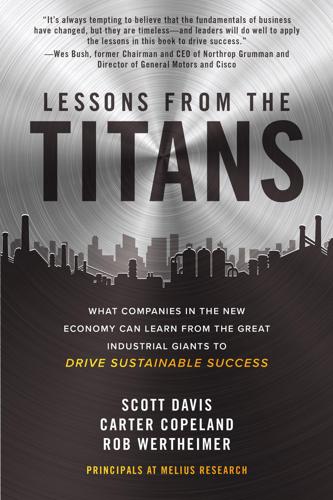
Lessons from the Titans: What Companies in the New Economy Can Learn from the Great Industrial Giants to Drive Sustainable Success
by
Scott Davis
,
Carter Copeland
and
Rob Wertheimer
Published 13 Jul 2020
The corporate folks involved in deal execution and integration needed to be exceptional, so Culp sought to build up that talent level to match the increasing needs of the organization. PROCESS IN EVERYTHING Culp knew that the DBS toolkit itself needed to be modernized, which largely meant adding tools that other organizations had developed and modifying them for Danaher’s needs. These included funnel management in sales, value engineering, voice of the customer, value pricing, and procurement and logistics tools, which were adopted for nearly every Danaher function. The commonality of those tools was not just in focusing staff and setting benchmarks to best in class, but in standardizing processes and adding predictability in a world that was becoming less predictable overall.
…
Kaizen itself just seems like a superorganized, time-limited, low-expectation brainstorming session—with the goal of immediately implementing incremental yet permanent improvements. Danaher insiders describe the process as kaizen/implement, and then rinse/repeat. Small increments of improvement, done in steps, become large increments of improvement over time. For example, value engineering kaizens may focus on reducing the number of parts of a product to simplify it, or standardizing parts with other SKUs. Kaizens in procurement could be for something as small as streamlining contract language, to full-blown efforts to improve some element of the supply chain, all done with little steps over time.
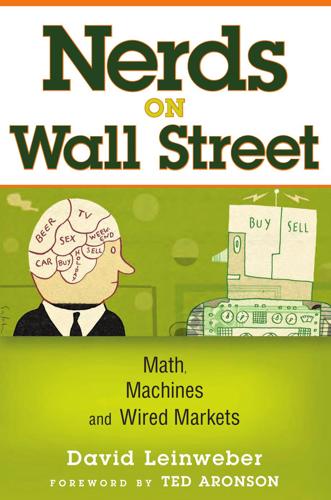
Nerds on Wall Street: Math, Machines and Wired Markets
by
David J. Leinweber
Published 31 Dec 2008
Details of the Sharpe ratio can be found at http:// en.wikipedia.org/wiki/Sharpe_ratio. Algorithm Wars 81 Both articles forecast an increasingly risk-centric view of trading. IBM opines, “As the industry matures, many traditional activities will come under increasing pressure and new value engines will emerge. Activities under pressure are unnecessary bundles and transaction businesses.Value engines will be risk assumption and risk mitigation.” (p. 1) How will these trends be reflected in algorithmic trading systems? If the shifts described occur as predicted, we can anticipate that clients will want to control trade path risk, and sell-side firms will want to accommodate them.
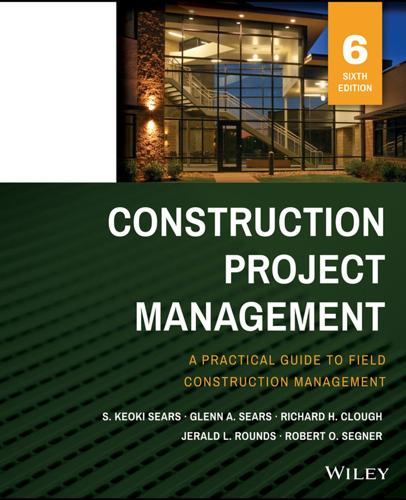
Construction Project Management
by
S. Keoki Sears
Published 7 Feb 2015
Construction management services can be performed for the owner for a stipulated fee by a range of firms, including design firms, contractors, and professional construction managers. Such services range from merely coordinating contractors during the construction phase to broad‐scale responsibilities over project planning and design, project organization, design document review, construction scheduling, value engineering, field cost monitoring, and other management services. Selection of the construction manager by the owner is sometimes accomplished by a best‐value approach, including both fee and qualifications as bases for contract awards. Usually, however, the construction management arrangement is considered to be a professional services contract and is negotiated.
…
Any change to a subcontract is accomplished by a formal change order. 12.17 Project Changes Changes in the work or deviations from the anticipated job‐site conditions can stem from a variety of causes. The owner or architect‐engineer may decide to add additional work or change certain contract requirements. The contractor may suggest construction changes in accordance with the contract’s value‐engineering clause. The owner, architect‐engineer, or another prime contractor may cause delay in the prosecution of the fieldwork. Job‐site conditions may be encountered that are appreciably different from those originally contemplated. Changes of this sort can result in work extra to the contract, extensions of contract time, and claims for additional costs.

St Pancras Station
by
Simon Bradley
Published 14 Apr 2007
None of which was, in the end, enough: at the turn [ 99 ] St Pancras.indb 99 13/9/07 12:12:11 of the year 1873–4 Scott was eased out in favour of the direct employment of the railway’s own preferred interior decorating contractor, Messrs Gillow. The architect was not used to this kind of brusque treatment, but he was no prima donna, and a public breach was avoided by both sides. This process of ‘value-engineering’ an accepted design before and during construction remains a familiar headache for architects. It was not a sign that the employment of a separate designer was a misconceived luxury. The Midland wanted the grandest of Grand Hotels, not least in order to attract traffic from its longer-established rivals at Euston and King’s Cross.
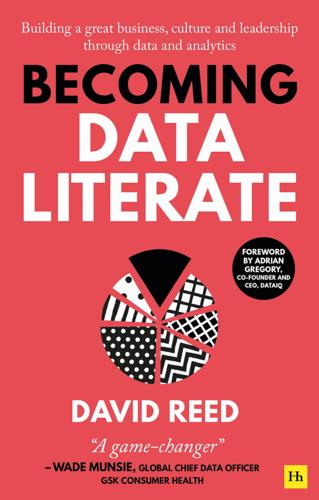
Becoming Data Literate: Building a great business, culture and leadership through data and analytics
by
David Reed
Published 31 Aug 2021
As noted earlier, when brand value became formally recognised as intellectual property and could be added to balance sheets when a company was being bought, sold or merged, many brand owners realised a mistake had been made in not amortising this value across a given period. As a result, tax mitigation cannot be applied by showing impairment to the brand value annually, for example, or value engineering applied to increase the price of a business during takeover negotiations. In consequence of this, many brands do not undergo formal valuation and recognition as an intellectual property asset. Digital taxation (or tax on digital transactions) seems highly likely to be a feature of the 2020s to help fund the support given by government to business during the Covid-19 crisis (and also to claw back some of the profits made by digital platforms).
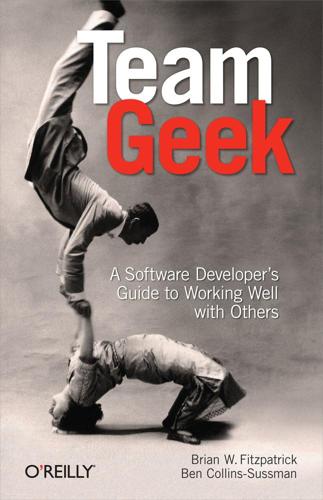
Team Geek
by
Brian W. Fitzpatrick
and
Ben Collins-Sussman
Published 6 Jul 2012
Typically you’ll see this directly in the form of unrealistic deadlines and lack of qualified technical people to get projects completed on time. You may have difficulty acquiring enough hardware to effectively run your product, or find your team spending weeks rewriting something when a hardware purchase costing only a few hundred dollars would have done the job. This is unfortunately typical of a company that doesn’t value engineers and treats them like slaves, giving them no voice in how the company operates. The most egregiously bad organizations have ossified command and control structures that resemble fiefdoms. Years ago, our friend Terrence worked at a company that had strict rules on passing bugs between teams, and eventually another team created a bug that caused Terrence’s product to run out of memory over the course of a few hours.
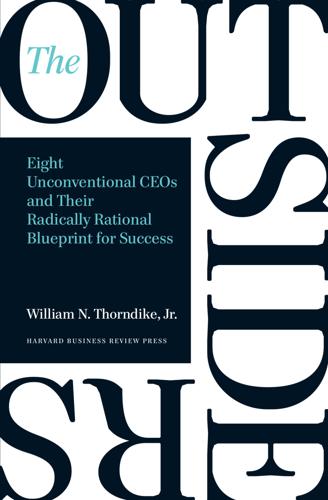
The Outsiders: Eight Unconventional CEOs and Their Radically Rational Blueprint for Success
by
William Thorndike
Published 14 Sep 2012
After Yale, Malone earned master’s and PhD degrees in operations research at Johns Hopkins. His two academic fields, engineering and operations, were highly quantitative and shared a focus on optimization, on minimizing “noise” and maximizing “output.” Indeed, Malone’s entire future career can be thought of as an extended exercise in hyperefficient value engineering, in maximizing output in the form of shareholder value and minimizing noise from other sources, including taxes, overhead, and regulations. After earning his PhD, Malone took a job at Bell Labs, the highly prestigious research arm of AT&T. There, he focused on studying optimal strategies in monopoly markets.
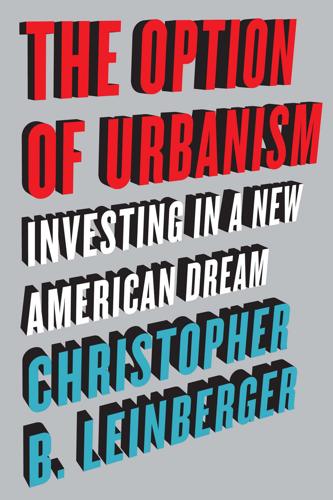
The Option of Urbanism: Investing in a New American Dream
by
Christopher B. Leinberger
Published 15 Nov 2008
Therefore, most equity is anything but patient, because it is so expensive. Drivable sub-urban development, with its nineteen standard product types, has evolved to require as little equity in the project as possible and return that equity as fast as possible. The result of this approach is the constant pressure to “value engineer” the cost of construction down and not build long-term, well built projects, especially because sprawl will probably just move the demand for the apartment project, neighborhood center, or hotel farther to the fringe in ten years or so. There is little reason to build well built projects because the current system of measuring financial AC H I E V I N G T H E N E X T A M E R I CA N D R E A M | 1 6 1 returns cannot see beyond years seven to ten; why build expensively when the benefits cannot be measured?
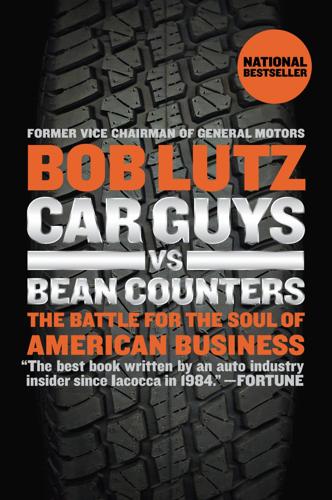
Car Guys vs. Bean Counters: The Battle for the Soul of American Business
by
Bob Lutz
Published 31 May 2011
The fact is, though, that my effort to instill into the organization a drive for perfection and customer delight in all things was successful. And still I wonder—was I right? Did I change the core of the product development culture by teaching, or did I rely too much on my own will and my considerable influence to get what I wanted? If the latter, excellence will soon be lost again, and “value engineering” and “Let’s see how much we can cut before the customers start complaining” will rear their ugly heads again. Death by a thousand small cuts, because anytime the company loses the focus of providing the very best it can, delighting the eye, ear, butt, and wallet of the customer more than the competitors do, the inevitable decline sets in.

Radical Cities: Across Latin America in Search of a New Architecture
by
Justin McGuirk
Published 15 Feb 2014
The bulk of the money went not to slum upgrading but to major infrastructural projects across the country, and so the first phase of Jáuregui’s intervention is fairly modest. We pass some new, boxy housing blocks that look, frankly, cheap. He is not proud of them. As in Rocinha, the contractors and the private investors value-engineered his design, simplifying the facade and reducing the size of the apartments. ‘The construction companies are a mafia,’ he says. Next to the housing, however, is a large square with trees and a fountain, and facing on to the square, in a former army barracks, is Manguinhos public library. Inside we are greeted by delicious air conditioning, a bright and spacious layout and rows of bookcases – well-stocked bookcases.
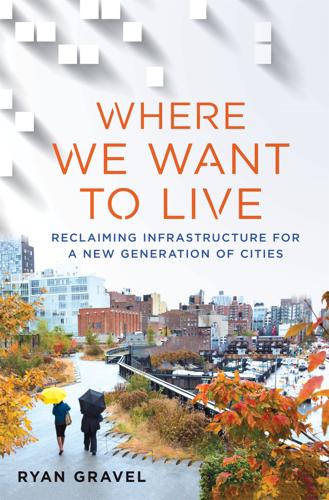
Where We Want to Live
by
Ryan Gravel
Published 2 Feb 2016
Infrastructure gets us home in time for dinner, lights our way on a romantic stroll, and draws our bath for a quiet evening at home without the kids. Of course infrastructure can also turn cold. It can limit our ability to do those things. If we want it to, infrastructure can almost ensure a dull and unproductive condition for living. The reason we so seldom think of infrastructure as sexy today is because we have value-engineered all the sex out of it. Simply understanding this intimate relationship between infrastructure and our way of life, however, is not enough. If we want to change things, we have to do something, and sometimes we need a catalyst—a kind of urban intervention—to jolt our way of thinking. We need something to show us not only why change is needed, but also that it’s possible.

Supertall: How the World's Tallest Buildings Are Reshaping Our Cities and Our Lives
by
Stefan Al
Published 11 Apr 2022
Some people even took the effort to demonstrate that the rays scorched the sidewalk hot enough to fry an egg. Editors had a heyday, coming up with new nicknames, including the “Fryscraper.” Architect Rafael Viñoly defended his actions, claiming he had proposed sun shading that would have avoided the hot rays. However, the developer had value-engineered these out of the project. Nevertheless, Viñoly himself had already encountered a similar problem in his design for another concave building, a hotel in Las Vegas known for its “Death Ray.” The reflective facade reflected the desert sunrays so intensely on the pool below that it could burn hair.

The Impulse Society: America in the Age of Instant Gratification
by
Paul Roberts
Published 1 Sep 2014
She loved designing buildings, but the architecture profession has become so dominated by a cost-cutting, high-volume mentality that creativity is an ever-smaller part of the job. “Most of the time, you’re just figuring out how to take money out of the project,” Marcie told me. “You’d design something and everyone would love it and then they’d say, ‘ok, let’s “value-engineer” the hell out of it.’ And I started thinking, ‘this building was going to be standing for fifty years, with my name is on it, and I don’t really agree with how we’re doing it.’ ” As it happened, Marcie had been volunteering with the local school district and leading students tours of the architecture downtown.
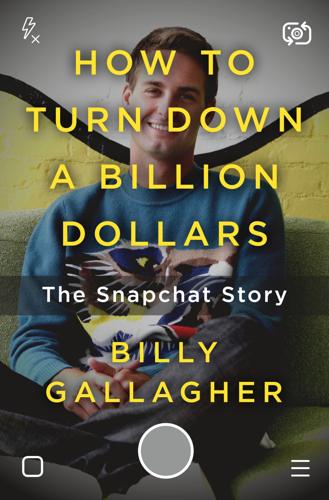
How to Turn Down a Billion Dollars: The Snapchat Story
by
Billy Gallagher
Published 13 Feb 2018
And finally, at Pinterest, a ghost lay next to falling bowling pins, asking, “FEELING PINNED DOWN?” All of the filters featured an address for Snapchat’s jobs page. It wasn’t always easy to convince talent to leave Silicon Valley for Los Angeles. There are so many great companies to work for in the San Francisco Bay Area, most of which value engineers more highly than Snapchat does. Several of the executives who lasted less than a year still had their families in the Bay Area; while this was not the primary reason that most of them parted ways, it certainly didn’t help. Those who joined Snapchat would work for Evan Spiegel in his kingdom.
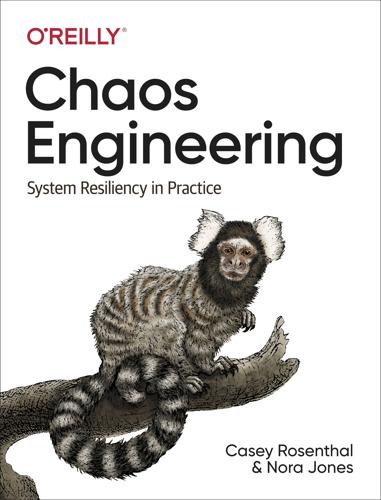
Chaos Engineering: System Resiliency in Practice
by
Casey Rosenthal
and
Nora Jones
Published 27 Apr 2020
Vary Real-World Events This advanced principle states that the variables in experiments should reflect real-world events. While this might seem obvious in hindsight, there are two good reasons for explicitly calling this out: Variables are often chosen for what is easy to do rather than what provides the most learning value. Engineers have a tendency to focus on variables that reflect their experience rather than the users’ experience. Avoid Choosing the Easy Route Chaos Monkey4 is actually pretty trivial for such a powerful program. It’s an open source product that randomly turns off instances (virtual machines, containers, or servers) about once a day for each service.
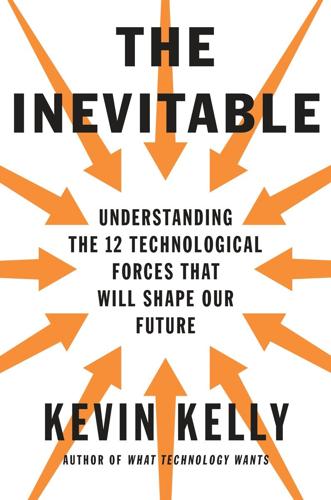
The Inevitable: Understanding the 12 Technological Forces That Will Shape Our Future
by
Kevin Kelly
Published 6 Jun 2016
• • • What is it that we are making with our question-and-answer machine? Our society is moving away from the rigid order of hierarchy toward the fluidity of decentralization. It is moving from nouns to verbs, from tangible products to intangible becomings. From fixed media to messy remixed media. From stores to flows. And the value engine is moving from the certainties of answers to the uncertainties of questions. Facts, order, and answers will always be needed and useful. They are not going away, and in fact, like microbial life and concrete materials, facts will continue to underpin the bulk of our civilization. But the most precious aspects, the most dynamic, most valuable, and most productive facets of our lives and new technology will lie in the frontiers, in the edges where uncertainty, chaos, fluidity, and questions dwell.
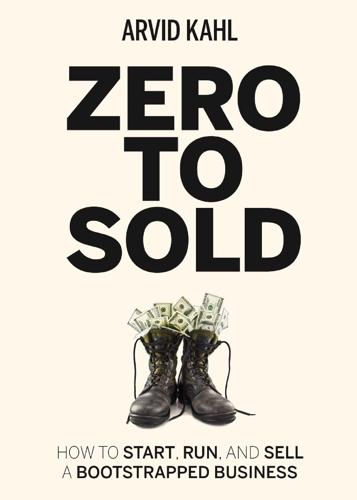
Zero to Sold: How to Start, Run, and Sell a Bootstrapped Business
by
Arvid Kahl
Published 24 Jun 2020
Everything that makes you more of an expert among few others will set you apart from your competition. Building the world's 15,000th invoicing module won't get you any closer to that goal. The worst part of building things that you don't need to build is that it’s distracting you from the primary mission of your business: creating a self-sustaining value engine that helps your customers solve their critical problem. If you're not focusing on making that a reality, you're straying from the path. Building things that you shouldn't build is often the result of a grandiose underestimation of the time required to get it right enough. For everything that sounds simple enough to build yourself but has many SaaS solutions out there, ask yourself if maybe the people who pay for it know more about the complexity of that feature than you do at this point.
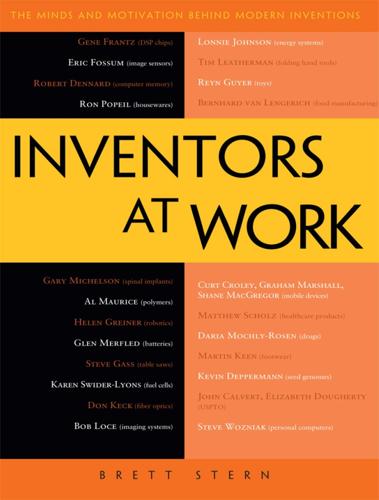
Inventors at Work: The Minds and Motivation Behind Modern Inventions
by
Brett Stern
Published 14 Oct 2012
Your tractor? Fossum: I do think hydraulics are pretty amazing. Stern: When you’re at a dinner party and people ask you what you do, what do you say? Fossum: That’s usually a pretty good way to kill a conversation, I’ve found in my experience. Stern: Why is that? Fossum: I won’t say people don’t value engineers or technical people, but it’s very hard to talk to other people about technical issues in a general setting. It’s hard for people to relate to that, so usually they just decide that they can’t understand what you’re saying and turn it off. If I tell them that basically I develop technology that makes their cell phone camera work, then they get excited.

Factory Man: How One Furniture Maker Battled Offshoring, Stayed Local - and Helped Save an American Town
by
Beth Macy
Published 14 Jul 2014
In 1999, Bassett and J.C. Penney had celebrated selling one billion dollars in furniture together with a big party in Dallas, near the company’s Plano headquarters. When Penney complained the following year that Bassett’s prices were too high compared with the imports’, Bassett redesigned—or “value-engineered,” as the marketing people called it—its bestselling Penney suites, slashing prices by as much as 33 percent. Over the course of the next three years, Penney cut its Bassett orders drastically, replacing them with similar Chinese-made products until the Bassett line was entirely phased out. Later, Penney officials insisted they had dumped Bassett because of quality problems, not price—a claim Bassett CEO Rob Spilman disputes to this day.
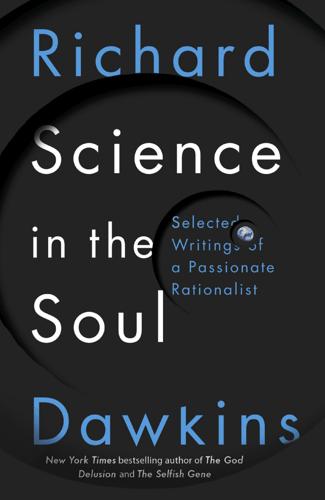
Science in the Soul: Selected Writings of a Passionate Rationalist
by
Richard Dawkins
Published 15 Mar 2017
It will be especially vulnerable to predators, or unable to catch prey. So why doesn’t natural selection thicken bones so that they never break? We humans, by artificial selection, could breed a race of, say, dogs, whose leg bones were so stout that they never broke. Why doesn’t nature do the same? Because of costs, and this implies a system of values. Engineers and architects are never asked to build unbreakable structures, impregnable walls. Instead, they are given a monetary budget and asked to do the best they can, according to certain criteria, within that constraint. Or they may be told: the bridge must bear a weight of ten tons, and must withstand gales three times more forceful than the worst ever recorded in this gorge.
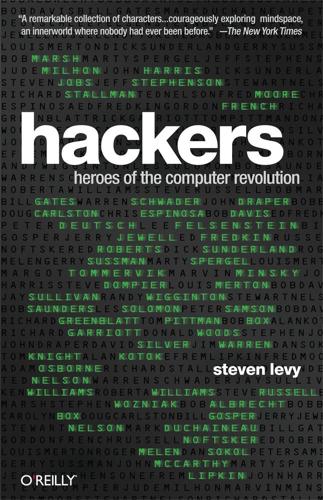
Hackers: Heroes of the Computer Revolution - 25th Anniversary Edition
by
Steven Levy
Published 18 May 2010
Then I’d look up and it had been four hours,” he says. “Now when I think an hour has gone by, I look up and it’s an hour.” It’s not just the passage of years that’s changed Hertzfeld’s experience. He’s also had to adapt his individualistic approach to serve the geek-industrial complex that is Google. On one hand, Google is a hacker Mecca. It values engineers as its most important asset. “You are expected to work out of your passion,” Hertzfeld says—definitely a hacker-friendly value. But Hertzfeld can’t duck the fact that Google is also a big company with firm standards and processes when it comes to designing products, which makes the whole process more formal and less fun.

The Innovators: How a Group of Inventors, Hackers, Geniuses and Geeks Created the Digital Revolution
by
Walter Isaacson
Published 6 Oct 2014
He also knew that the low price would stimulate demand, high-volume production, and economies of scale, which would turn Moore’s Law into a reality.24 Fairchild Camera and Instrument decided, not surprisingly, to exercise its right to buy out Fairchild Semiconductor in 1959. That made the eight founders rich but sowed seeds of discord. The corporation’s East Coast executives refused to give Noyce the right to hand out stock options to new and valued engineers, and they sucked up the semiconductor division profits to fund less successful investments in more mundane realms, such as home movie cameras and stamp machines. There were also internal problems in Palo Alto. Engineers began defecting, thus seeding the valley with what became known as Fairchildren: companies that sprouted from spores emanating from Fairchild.

Seeking SRE: Conversations About Running Production Systems at Scale
by
David N. Blank-Edelman
Published 16 Sep 2018
We need to be thoughtful about how we balance work that people love with work the company needs to get done. Good managers are proactive about transferring out an engineer who cannot make progress on a team’s workload due to a mismatch in interest or skills. Great managers expand their team’s remit to make better use of the engineers they have, so they feel their skills and talents are valued. Engineers whose skills go unused grow frustrated. Engineers who are ill-equipped to succeed at assigned work will feel set up to fail. Make respect part of your team’s culture It’s difficult to give 100% if you spend mental energy pretending to be someone else. We need to make sure people can be themselves by ensuring that we say something when we witness disrespect.

Palo Alto: A History of California, Capitalism, and the World
by
Malcolm Harris
Published 14 Feb 2023
By the 1970s, mechanization reduced the proportion of production workers in semiconductor employment to less than half, while the relative share of managers, engineers, and marketers increased.6 Firms adapted a bifurcated labor model, holding manufacturing wages 20 percent below the national average while electronics professionals did significantly better financially than professionals in slower industries did.7 Again, this was no coincidence: Electronics firms rewarded their managers for controlling labor costs. It seems counterintuitive to pay some workers not to pay other workers, but by using stock options and grants to align professional employees’ interest with ownership, firms could provide a paternalistic atmosphere for high-value engineers while keeping the aggregate wage low enough to generate double-digit profits even as prices fell.iii Chip makers pursued a similarly bifurcated model for sales, vending monopolized custom setups at high markups and mass-producing other chips so cheaply that competitors couldn’t compete. Foreign capital poured into America and into Santa Clara County in particular as investors looked for ways to hedge against inflation, which soared above 10 percent.